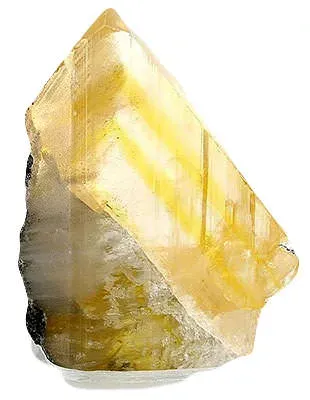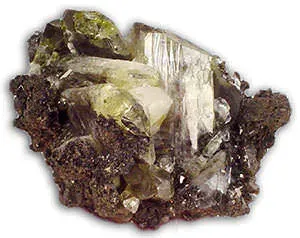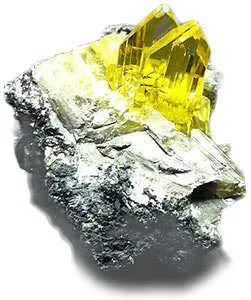 Anglesite is a transparent to translucent stone. It ranges in color from white, yellow, gray, pale green, brown, blue and colorless. It may be of a dark grey color if it is impure. Anglesite is most often colorless or colorless with a slight yellow tinge. Sometimes the stone is purple or black. The black color is due to inclusions of galena.
Anglesite is a transparent to translucent stone. It ranges in color from white, yellow, gray, pale green, brown, blue and colorless. It may be of a dark grey color if it is impure. Anglesite is most often colorless or colorless with a slight yellow tinge. Sometimes the stone is purple or black. The black color is due to inclusions of galena.
 Anglesite occurs in weathered deposits of lead ore, formed by the oxidation of deposits of galena. It is actually found as coatings, or crusts on galena, and can either be masses surrounding a galena core, or crystals, which fill the cavities of galena. Anglesite is often confused with cerussite, wulfenite, smithsonite mimetite, pyromorphite, and limonite.
Anglesite occurs in weathered deposits of lead ore, formed by the oxidation of deposits of galena. It is actually found as coatings, or crusts on galena, and can either be masses surrounding a galena core, or crystals, which fill the cavities of galena. Anglesite is often confused with cerussite, wulfenite, smithsonite mimetite, pyromorphite, and limonite.
 Anglesite is part of the baryte group. It shares the same structure as baryte, and has similar looking crystals that are normally found as flat blades or pendent columns jutting from a rock. However, anglesite is 50% more dense than the already heavy baryte, due to its lead content, which is 74 %.
Anglesite is part of the baryte group. It shares the same structure as baryte, and has similar looking crystals that are normally found as flat blades or pendent columns jutting from a rock. However, anglesite is 50% more dense than the already heavy baryte, due to its lead content, which is 74 %.
 Some of the best anglesite gems come from Tsumeb, Namibia, where high-luster,
Some of the best anglesite gems come from Tsumeb, Namibia, where high-luster, ![]() diamond shaped deposits measuring as large as 20 inches have been found. Other sites of anglesite include Broken Hill, Australia, Leadhills, Scotland, Cumbia, England, North Rhine-Westphalia, Germany, the Cagliari province, Sardinia, and Oujda, Morocco. Anglesite is also found in various locations around the United States, such as Chester County, Pennsylvania, Dividend, Utah, and Bingham, New Mexico. The most highly prized anglesite crystals come from Tsumeb, Namibia, and Toussit, Morocco.
diamond shaped deposits measuring as large as 20 inches have been found. Other sites of anglesite include Broken Hill, Australia, Leadhills, Scotland, Cumbia, England, North Rhine-Westphalia, Germany, the Cagliari province, Sardinia, and Oujda, Morocco. Anglesite is also found in various locations around the United States, such as Chester County, Pennsylvania, Dividend, Utah, and Bingham, New Mexico. The most highly prized anglesite crystals come from Tsumeb, Namibia, and Toussit, Morocco.